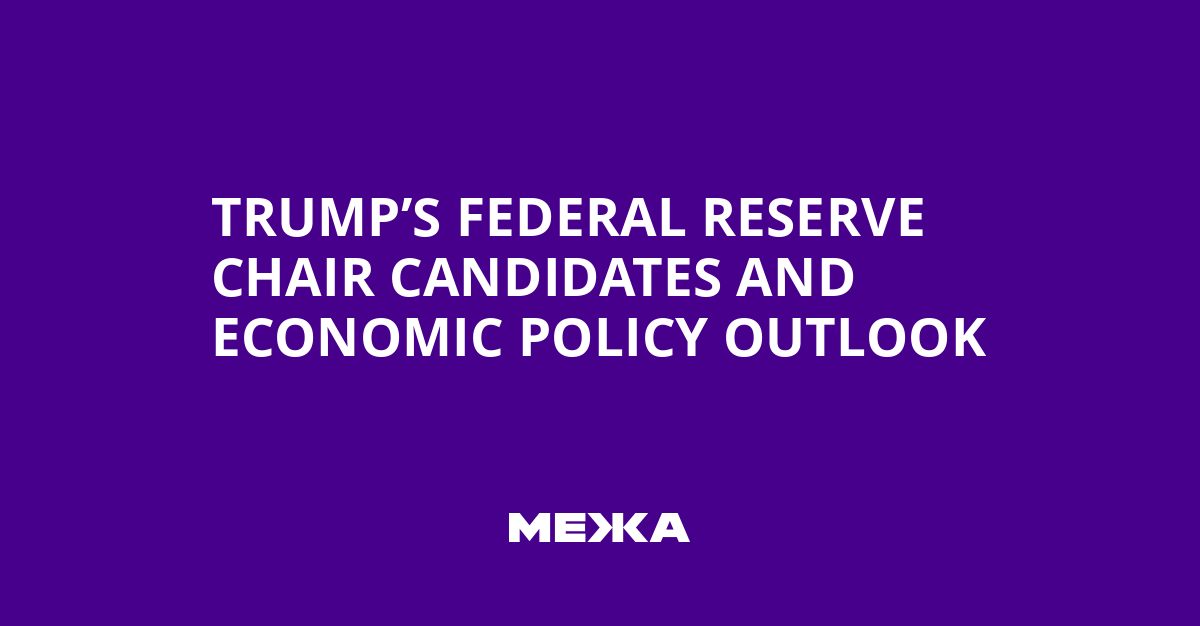President Donald Trump recently put one of his economic advisers on the path to the upper echelons of the Federal Reserve System, but his next move could have far greater consequences. A strategy for appointing a new head of the Fed is already taking shape, as the most influential decision in monetary policy requires careful weighing.
On Thursday, Trump nominated economist Stephen Miran from the White House to the temporary vacancy on the Federal Reserve’s Board of Governors, but his candidacy still must be confirmed by the Senate. This appointment could affect the regulator’s work in the coming months, even if it is only a temporary role.
Meanwhile, the Trump administration is actively conducting interviews with candidates for a more senior position – the future chair of the Fed. The current chair, Jerome Powell, does not always meet the president’s expectations regarding the rate, while his term is due to expire roughly in the spring.
Last week, the selection process showcased a range of trajectories that Trump is carefully weighing, given his repeated remarks about potential disappointment with Powell’s nomination.
Trump has already said he no longer considers Treasury Secretary Scott Bessent for the Fed chair. Instead, Christopher Waller, a current member of the Fed Board, unexpectedly gained support within the president’s inner circle. Also in the short list remain former Fed Board member Kevin Warsh and White House economist Kevin Hassett. There is a possibility that Miran, if confirmed, could be elevated to Fed chair.
On Friday The Wall Street Journal reported that Trump expanded the list of candidates for the Fed chair, adding former President of the Federal Reserve Bank of St. Louis James Bullard to it.
“It will be interesting to see how all this unfolds, for two Kevins are certainly viable candidates, but Waller may be the one the market will force to choose.”
– Derek Tang, economist LH Meyer/Monetary Policy Analytics
Christopher Waller, who joined the Fed Board in 2020, is today regarded as one of the key voices in monetary policy, making his stance highly influential for the Fed’s future direction.
After the regulator tightened policy with rate hikes in 2022 and 2023 to curb inflation, investors have been watching his remarks closely for signals about possible rate cuts. Such statements are often priced into the market through forward guidance – the tool by which the Fed interprets its future steps.
In recent months, Waller has stood out among the 12 members of the Fed’s rate-setting committee, showing a clear stance on the trajectory of monetary policy.
Last month he was one of two Fed Board members who dissented from the decision to hold rates for the fifth consecutive meeting, instead supporting their reduction. This was the first time since 1993 that more than one Board member did not back a monetary policy decision at a single meeting.
In a statement explaining his dissent, Waller concluded that “tariffs are a one-time increase in price levels and do not cause inflation beyond temporary rise,” pointing to the need to cut rates to prevent a threat to the labor market.
According to people close to the process, Trump’s advisers repeatedly cited Waller’s dissent during presentations to the president, boosting his chances of the Fed chair role.
Warsh, a long-time ally of Trump, was previously considered as a candidate for Fed chair during the first term of the administration, but Powell then received support on the advice of the then-finance secretary. Hassett, a PhD in economics with a long-standing record of supporting Republican policymakers, is also among the favorites thanks to his positions on tariff policy and influence on economic decisions.
“The president clearly trusts Kevin Warsh and holds him in high regard, and, as I understand it, his in-laws are close to the Trump family, so there is a personal connection.”
– Brian Gardner, Chief Policy Strategist at Stifel
Warsh was previously considered as a candidate for Fed chair during Trump’s first term, but then Powell was chosen on the advice of the then-finance secretary Steven Mnuchin.
Before Waller’s dissent boosted his standing with Trump, Hassett was regarded as the favorite for the Fed chair, supporting the administration’s broad economic program. He has repeatedly stressed that tariffs should not cause substantial harm to American consumers, as negotiations could yield new terms.
“People expect Hassett to eventually be nominated, because he works in the White House and undeniably has a high level of loyalty, given his ties to Trump from the first administration.”
– Derek Tang, economist LH Meyer/Monetary Policy Analytics
Both candidates – Warsh and Hassett – have remained steadfast adherents to the idea that the Fed should maintain independence from political pressure. The current task is to find a balance between political sensitivity and the professional grounding of monetary policy.
Note that the preparation of this material was aided by industry experts who serve to explain the processes at the Fed and the potential impact of their decision on the country’s economy. The unfolding of events in the near future will determine which candidate can realistically head the central bank and how this will reflect on rates and inflation.
In any case, the future main challenge for the Fed is to maintain a balance between price stability and conditions for economic growth. As we await an official decision, we can only watch the shifting balance of power in the capital, where every move affects the financial market and the daily lives of citizens.
